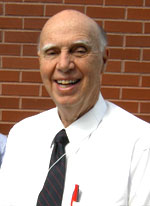Year: 2005
The ?two-frame light travel problem? is best seen by considering spherical waves from a moving source as seen by an observer Q on that ?moving? frame and by an observer P on a ?stationary? frame. When those two simultaneous views are precisely plotted on a sin-gle graph, it?s clear that each part of a wave must be at two locations at the same instant as described in more detail in this paper. That?s true whether relativistic or non-relativistic equations are used -- as long as aether is not assumed. Such wave discontinuities are impossible in a logical world and are contrary to an enormous amount of Doppler data which would certainly reveal those discontinuities if they existed. The discontinuities disappear if we return to Doppler?s original [1842] equations which were based on presence of an ?aether?. Unfortunately, Doppler was counseled to drop his longitudinal light wave views soon after 1842 and the discontinuities without an ether have remained unseen since then. Texts, c.f., Hansch, do use Doppler?s 1842 light equations for sound waves in air but shift to relativity?s equations for optical Doppler which ignore the light wave discontinuities. Attempts by Ritz are discussed but do not eliminate discontinuities in all conditions. If confirmed by additional experiments, this finding is yet another reason to reject relativity?s concepts and should be of interest in electrodynamics and astronomy. One such use might be to help explain the excess red-shift occasionally seen in astronomy. When coupled with the refutation of relativity?s presumed limits of speed to c , as discussed in a companion paper, light waves from a super-luminal light emitter would arrive at an observer at constant c but in reverse order with seemingly increased wavelengths.
This paper is aka "Doppler?s 1842 Aether-based Concepts Provide the Only Known Solution to the Two-Frame Light Travel Problem, and Possibly Other Concerns in Astronomy"


